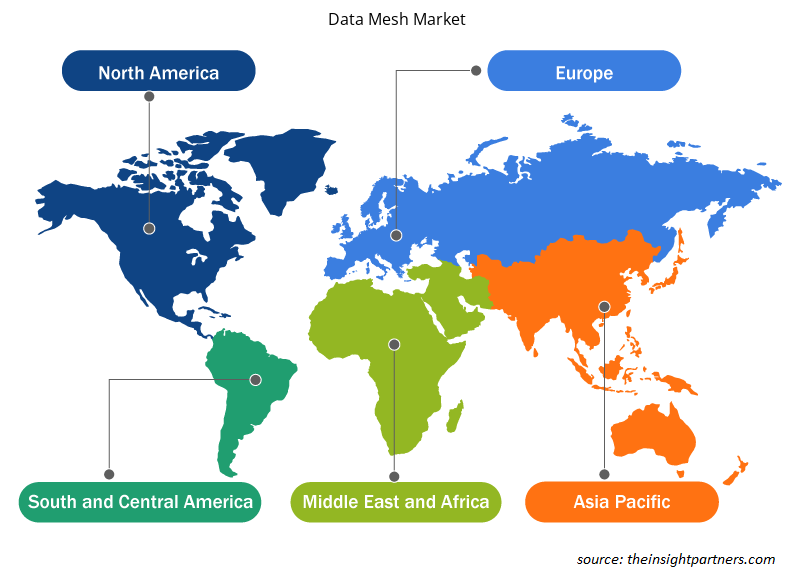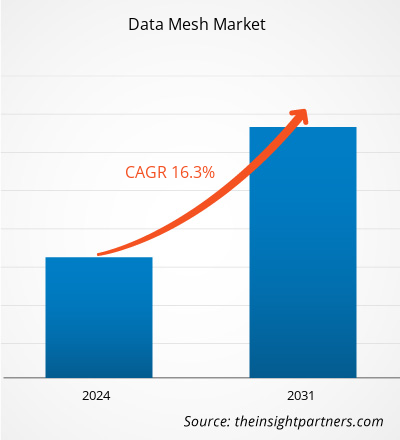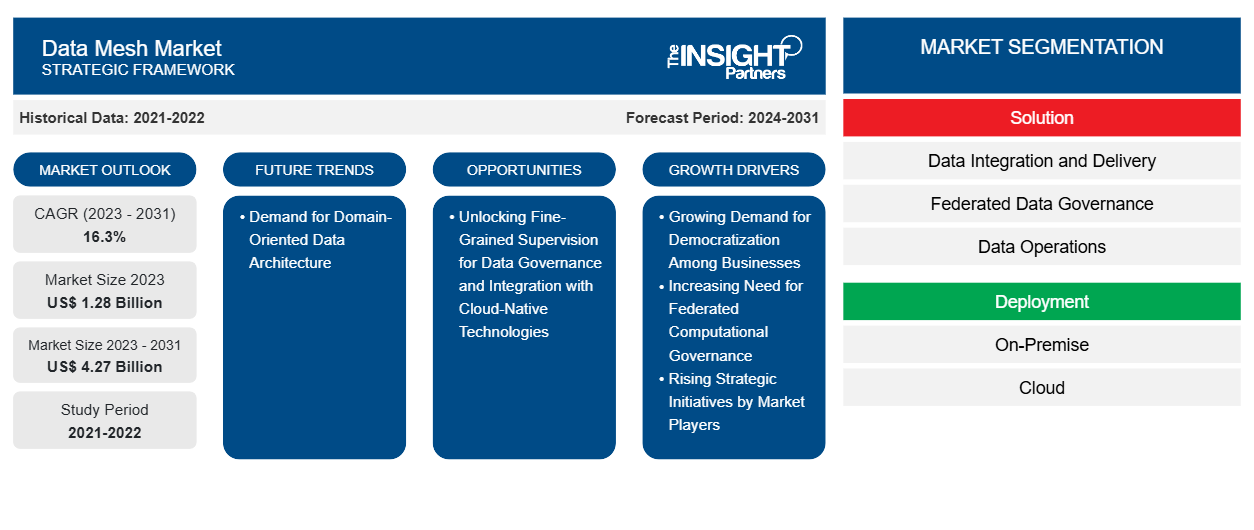数据网格市场规模预计将从 2023 年的 12.8 亿美元增至 2031 年的 42.7 亿美元。预计 2023 年至 2031 年期间市场复合年增长率为 16.3%。在预测期内,混合和多云环境的采用率不断提高可能会带来新的数据网格市场趋势。
数据网格市场分析
对 AI、ML、物联网和大数据分析工具和技术的投资不断增加,推动了数据网格市场的发展。此外,全球消费者越来越多地采用数据集成和交付解决方案,预计将在预测期内为数据网格市场的增长创造机会。
数据网格市场概览
数据网格是一种去中心化的数据架构,专注于改善组织内的数据管理和可访问性。数据网格架构用于提高数据质量、分析和决策能力,这增加了全球企业对它的需求。数据网格解决方案成功满足了企业不断变化的需求,这些企业在数据驱动的环境中寻求创造力和创新、明智的决策和灵活性。
定制此报告以满足您的需求
您可以免费定制任何报告,包括本报告的部分内容、国家级分析、Excel 数据包,以及为初创企业和大学提供优惠和折扣
-
获取此报告的关键市场趋势。这个免费样品将包括数据分析,从市场趋势到估计和预测。
数据网格市场驱动因素和机遇
企业对民主化和可访问性的需求不断增长,推动数据网格市场增长
企业对数据民主化的需求日益增长,推动了数据网格市场的发展。数据民主化需要数据网格架构来管理大数据。数据网格架构标志着一种变革,它为企业提供了快速访问企业内部准确和相关数据的途径。全球许多企业正在通过创造一种自由访问、理解和使用特定数据和职责的氛围来打破存储大数据的传统方法。这种民主化方法允许即时访问情境化和实时数据,并鼓励团队和企业之间的协作,从而促进更快的决策。
企业对数据网格策略的需求不断增长,其采用率也不断提高,推动了市场的增长。数据网格策略促进了基于团队的数据所有权和责任制文化,激发了创造力,提高了企业生产力。这些策略允许企业将数据结构化为可管理和自助服务域。此过程可确保用户可以轻松访问、理解和使用数据。此外,企业对用于管理和处理不同领域数据的数据网格解决方案的需求不断增长,这也推动了市场的发展。
解锁数据治理的细粒度监管以及与云原生技术的集成
联合计算治理是一种框架,通过确保互连数据域之间的质量、安全性和合规性来促进协作和决策。联合计算治理环境使得建立联合数据所有权成为可能,以确保数据的安全性、质量和隐私性。该环境由特定领域的专家使用,而不是由中央管理机构使用,用于适当管理组织特定领域中的大量数据,包括营销和销售、人力资源、财务和会计、研发等。例如,根据 2023 年 8 月的 ZipDo 报告,金融行业对大数据和业务分析的投资在 2023 年达到 1002 亿美元,比 2020 年增长 43.0%。财务和会计领域每天都要处理大量数据,这增加了组织对数据网格解决方案的需求,以便准确管理和做出实时决策。数据网格鼓励领域专家和数据管理员产生责任感和主人翁意识。这种分布式所有权使治理技术更接近财务和会计数据领域的细微差别和复杂性,预计将在预测期内为市场创造机会。
数据网格市场报告细分分析
有助于得出数据网格市场分析的关键部分是解决方案、部署、应用和垂直行业。
- 根据解决方案,数据网格市场分为数据集成和交付、联合数据治理、数据操作、数据转换和编排等。数据集成和交付部分在 2023 年占据了最大的市场份额。
- 数据集成和交付解决方案用于组合来自各种来源的数据,从而增加企业在管理人力资源、财务会计、供应链和其他职能方面的采用。
- 企业对数据集成和交付解决方案的需求不断增长,以确保用户数据的准确性和一致性,从而推动了该领域市场的发展。
数据网格市场份额(按地区)分析
- 数据网格市场分为五大区域——北美、欧洲、亚太地区 (APAC)、中东和非洲 (MEA) 以及南美和中美。
- 就收入而言,北美占据了数据网格市场份额的主导地位。由于该地区对大数据技术的采用和投资很高,该地区在全球数据网格市场趋势的扩张中贡献了显著的份额。
- 由于微软公司、亚马逊网络服务公司、Alphabet 公司、甲骨文公司、国际商业机器公司、Snowflake 公司、K2view 有限公司、Denodo Technologies 公司和 Informatica 公司等主要市场参与者的存在,预计美国市场将在预测期内扩大。这些参与者不断致力于开发新的先进技术并签署合作协议以吸引全球客户。例如,2023 年 4 月,国际商业机器公司与西门子股份公司合作开发集成软件解决方案。此次合作有助于两家公司加强长期合作,以开发用于管理大量数据的集成软件解决方案。
- 此外,预计预测期内对人工智能和大数据分析等先进技术的需求不断增长将有助于北美数据网格市场规模的不断增长。
数据网格市场区域洞察
Insight Partners 的分析师已详细解释了预测期内影响数据网格市场的区域趋势和因素。本节还讨论了北美、欧洲、亚太地区、中东和非洲以及南美和中美洲的数据网格市场细分和地理位置。

- 获取数据网格市场的区域特定数据
数据网格市场报告范围
| 报告属性 | 细节 |
|---|---|
| 2023 年的市场规模 | 12.8亿美元 |
| 2031 年市场规模 | 42.7亿美元 |
| 全球复合年增长率(2023 - 2031) | 16.3% |
| 史料 | 2021-2022 |
| 预测期 | 2024-2031 |
| 涵盖的领域 |
按解决方案
|
| 覆盖地区和国家 |
北美
|
| 市场领导者和主要公司简介 |
|
数据网格市场参与者密度:了解其对业务动态的影响
数据网格市场正在快速增长,这得益于最终用户需求的不断增长,而这些需求又源于消费者偏好的不断变化、技术进步以及对产品优势的认识不断提高等因素。随着需求的增加,企业正在扩大其产品范围,进行创新以满足消费者的需求,并利用新兴趋势,从而进一步推动市场增长。
市场参与者密度是指在特定市场或行业内运营的企业或公司的分布情况。它表明在给定市场空间中,相对于其规模或总市场价值,有多少竞争对手(市场参与者)存在。
在数据网格市场运营的主要公司有:
- 思爱普
- 微软公司
- Alphabet 公司
- 甲骨文公司
- 国际商业机器公司
- 亚马逊公司
免责声明:上面列出的公司没有按照任何特定顺序排列。

- 获取数据网格市场顶级关键参与者概览
数据网格市场新闻和最新发展
数据网格市场通过收集一手和二手研究后的定性和定量数据进行评估,其中包括重要的公司出版物、协会数据和数据库。以下列出了数据网格市场的一些发展情况:
- 国际商业机器公司的 Cloud Pak for Data 团队宣布 Cloud Pak for Data (CPD) 4.8 版正式发布。Cloud Pak for Data (CPD) 4.8 的更新版本侧重于可维护性,以增强 CPD 平台和服务的管理和维护。4.8 版还提供了广泛的功能,可提供有关平台的更多信息,并主动确保 CPD 生产工作负载的稳定环境。(来源:国际商业机器公司,新闻稿,2023 年 12 月)
- Oracle 公司和微软公司扩大了合作伙伴关系,推出了 Oracle Database Azure,这是一种在 Azure 数据中心提供 Oracle Database 服务的新解决方案。Oracle Database Azure 为用户提供了直接访问在 Oracle Cloud Infrastructure (OCI) 上运行并部署在 Azure 数据中心的 Oracle 数据库服务的好处。这为客户在运行和管理工作负载方面提供了更大的灵活性。(来源:Oracle 公司,新闻稿,2023 年 9 月)
- Informatica Inc 在亚马逊网络服务 (AWS) 日本地区推出了智能数据管理 (IDMC) 云,以支持其客户实现数据主导的云现代化。IDMC 通过遵守其在该国客户的数据驻留要求,支持 Informatica Inc 访问、管理和加速数据转换以获得业务洞察。(来源:Informatica Inc,新闻稿,2023 年 6 月)
数据网格市场报告覆盖范围和交付成果
“数据网格市场规模和预测(2021-2031)”对市场进行了详细的分析,涵盖了以下领域:
- 数据网格市场规模以及范围涵盖的所有关键细分市场的全球、区域和国家层面的预测
- 数据网格市场趋势以及市场动态,如驱动因素、限制因素和关键机遇
- 详细的 PEST/波特五力分析和 SWOT 分析
- 数据网格市场分析涵盖主要市场趋势、全球和区域框架、主要参与者、法规和最新市场发展
- 行业格局和竞争分析,涵盖市场集中度、热图分析、知名参与者以及数据网格市场的最新发展
- 详细的公司简介
- 历史分析(2 年)、基准年、预测(7 年)及复合年增长率
- PEST和SWOT分析
- 市场规模、价值/数量 - 全球、区域、国家
- 行业和竞争格局
- Excel 数据集
近期报告
相关报告
客户评价
购买理由
- 明智的决策
- 了解市场动态
- 竞争分析
- 客户洞察
- 市场预测
- 风险规避
- 战略规划
- 投资论证
- 识别新兴市场
- 优化营销策略
- 提升运营效率
- 顺应监管趋势























 获取免费样品 - 数据网格市场
获取免费样品 - 数据网格市场